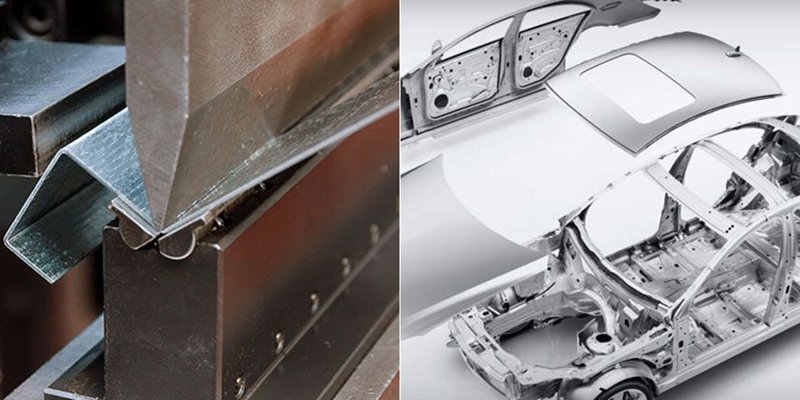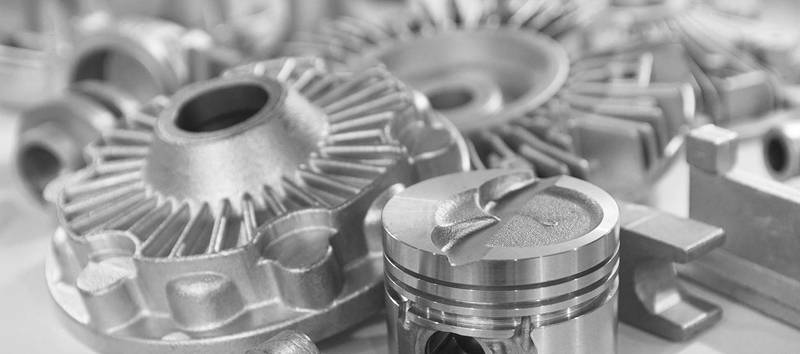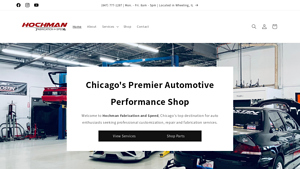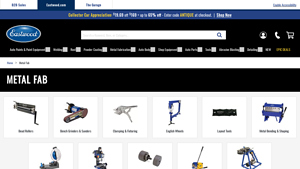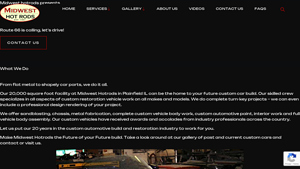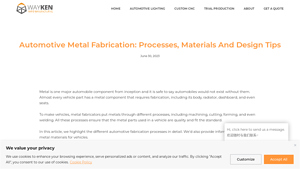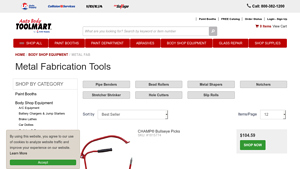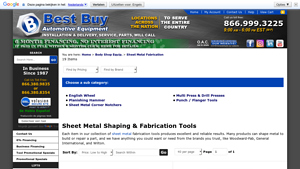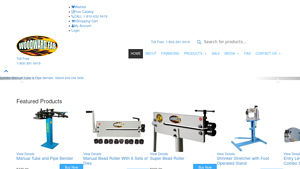Automotive Metal Fabrication Guide: Type, Cost, Top List…
Introduction: Navigating the Global Market for automotive metal fabrication
In the ever-evolving landscape of the automotive industry, navigating the global market for automotive metal fabrication poses a significant challenge for international B2B buyers. With a multitude of processes, materials, and suppliers, sourcing high-quality metal components that meet stringent industry standards can be daunting. This guide provides a comprehensive overview of automotive metal fabrication, exploring various methods such as casting, cutting, welding, and stamping, alongside the ideal materials for diverse applications.
We delve into the intricacies of supplier vetting, cost considerations, and the latest technological advancements shaping the industry. By offering actionable insights and practical advice, this guide empowers B2B buyers from Africa, South America, the Middle East, and Europe—including key markets like Brazil and Germany—to make informed purchasing decisions. Whether you are looking for precision parts for mass production or specialized components for niche applications, understanding the nuances of automotive metal fabrication will enable you to enhance your supply chain efficiency and product quality.
As the demand for innovative automotive solutions continues to rise, equipping yourself with the right knowledge is essential for maintaining a competitive edge in the global marketplace. This guide serves as your roadmap to success in sourcing and procuring top-tier automotive metal fabrication services.
Understanding automotive metal fabrication Types and Variations
| Type Name | Key Distinguishing Features | Primary B2B Applications | Brief Pros & Cons for Buyers |
|---|---|---|---|
| Automotive Metal Casting | Involves pouring molten metal into molds; suitable for mass production. | Chassis parts, engine components, transmission systems. | Pros: Ideal for high-volume production; consistent quality. Cons: Higher initial tooling costs; longer lead times. |
| Automotive Metal Cutting | Utilizes various techniques (laser, plasma, waterjet) to shape metal. | Body panels, chassis, engine parts, custom components. | Pros: High precision; quick turnaround for prototypes. Cons: Material waste can be higher; may require complex setups. |
| Automotive Metal Stamping | Uses dies to shape or cut metal sheets; efficient for high-volume runs. | Brackets, enclosures, fuel injectors, and other small parts. | Pros: Cost-effective for large quantities; high repeatability. Cons: Limited to flat materials; tooling costs can be significant. |
| Automotive Metal Welding | Joins metal parts using heat and pressure; versatile for various shapes. | Brackets, frames, exhaust systems, and structural components. | Pros: Strong and durable joints; adaptable to various designs. Cons: Requires skilled labor; can be slower than other methods. |
| Automotive Metal Machining | Removes material to achieve desired shapes; includes drilling and milling. | Precision parts, custom components, and prototypes. | Pros: High accuracy and finish; suitable for low to medium volumes. Cons: Can be time-consuming; higher costs for small runs. |
What Are the Key Characteristics of Automotive Metal Casting?
Automotive metal casting is a foundational process in the automotive industry, enabling the mass production of complex parts. This method involves pouring molten metal into molds, allowing it to solidify and take shape. It is particularly suitable for high-volume production runs, making it ideal for components like chassis parts and engine blocks. B2B buyers should consider the initial tooling costs and longer lead times associated with this method, which can impact project timelines.
How Does Automotive Metal Cutting Benefit Manufacturers?
Metal cutting encompasses various techniques such as laser cutting, plasma cutting, and waterjet cutting, allowing manufacturers to create precise shapes and sizes. This process is particularly advantageous for producing body panels and custom components due to its speed and accuracy. B2B buyers should weigh the benefits of precision against potential material waste and the complexity of setups required for different cutting techniques.
What Advantages Does Automotive Metal Stamping Offer?
Automotive metal stamping employs dies to shape and cut metal sheets, making it a highly efficient process for producing parts in bulk. This technique is commonly used for components like brackets and fuel injectors. For B2B buyers, the main advantages include cost-effectiveness for large runs and high repeatability. However, buyers must consider the limitations regarding material types and the significant initial investment in tooling.
Why Is Automotive Metal Welding Important in Fabrication?
Welding is a versatile process that joins metal components using heat and pressure, making it essential for creating strong, durable parts. It is widely used for structural components such as frames and exhaust systems. B2B buyers should note that while welding provides robust solutions, it requires skilled labor and may take longer compared to other fabrication methods. The adaptability of welding to various designs is a significant advantage for custom projects.
How Does Automotive Metal Machining Fit into the Fabrication Landscape?
Machining involves removing material from a workpiece to achieve precise shapes and finishes through processes like drilling and milling. It is particularly suitable for low to medium-volume production of custom components. B2B buyers should appreciate the high accuracy and finish achievable through machining, but they must also account for the potential time investment and costs associated with smaller production runs, which can be higher than other methods.
Key Industrial Applications of automotive metal fabrication
| Industry/Sector | Specific Application of Automotive Metal Fabrication | Value/Benefit for the Business | Key Sourcing Considerations for this Application |
|---|---|---|---|
| Automotive Manufacturing | Production of chassis and body components | Enhances vehicle safety and performance | Supplier certifications, material quality, lead times |
| Aftermarket Automotive | Custom brackets and enclosures for upgrades | Improves vehicle functionality and customization | Precision requirements, compliance with standards |
| Heavy Equipment | Fabrication of metal parts for trucks and trailers | Increases durability and load capacity | Material specifications, weight considerations |
| Aerospace | Manufacturing of specialized automotive components | Meets stringent safety and performance regulations | Quality assurance, certifications (AS9100, ISO) |
| Electronics | Fabrication of housings for automotive electronics | Protects sensitive components from damage | Compatibility with existing systems, material sourcing |
How is Automotive Metal Fabrication Used in Automotive Manufacturing?
In automotive manufacturing, metal fabrication is essential for producing chassis and body components. These elements not only form the vehicle’s structure but also contribute to its safety and performance. By utilizing advanced techniques like stamping, machining, and welding, manufacturers can ensure that components meet rigorous quality standards. For international buyers, especially from regions like Africa and South America, it is crucial to source suppliers with proven certifications and high-quality materials to guarantee that the final products are reliable and compliant with local regulations.
What Role Does Automotive Metal Fabrication Play in the Aftermarket Automotive Sector?
The aftermarket automotive sector relies heavily on automotive metal fabrication for creating custom brackets and enclosures that enhance vehicle functionality. These components allow for upgrades and modifications tailored to specific customer needs, thus adding value to the vehicle. Buyers in this sector should focus on precision manufacturing capabilities and compliance with industry standards to ensure that parts fit seamlessly and perform optimally. Additionally, sourcing from suppliers with a robust inventory can facilitate quicker turnaround times for urgent projects.
How is Metal Fabrication Applied in Heavy Equipment?
In the heavy equipment industry, automotive metal fabrication is crucial for producing durable metal parts for trucks and trailers. These components are designed to withstand harsh conditions while maximizing load capacity. Buyers must consider material specifications, such as strength and weight, to ensure that the fabricated parts can endure the demands of heavy-duty applications. Sourcing from manufacturers with experience in heavy equipment fabrication can provide the necessary expertise to meet these specific needs.
Why is Aerospace Industry Interested in Automotive Metal Fabrication?
The aerospace industry utilizes automotive metal fabrication for manufacturing specialized automotive components that meet stringent safety and performance regulations. This sector demands high precision and reliability, as even minor defects can lead to significant safety risks. Buyers from aerospace must ensure that their suppliers hold relevant certifications, such as AS9100, and have a robust quality assurance process in place to mitigate risks and ensure compliance with international standards.
What is the Importance of Automotive Metal Fabrication in Electronics?
In the electronics sector, automotive metal fabrication is vital for creating housings that protect sensitive automotive electronic components from environmental damage. These enclosures must be precisely fabricated to ensure compatibility with existing systems while providing durability and shielding from electromagnetic interference. Buyers should prioritize sourcing materials that meet specific thermal and electrical properties, as well as suppliers that can provide comprehensive testing and certification to ensure product integrity.
3 Common User Pain Points for ‘automotive metal fabrication’ & Their Solutions
Scenario 1: Navigating Quality Control Challenges in Automotive Metal Fabrication
The Problem: A B2B buyer in the automotive sector may face significant challenges with quality control when sourcing metal components. Variability in manufacturing processes can lead to inconsistencies in part dimensions, material properties, and overall performance. This inconsistency can result in costly production delays, increased scrap rates, and ultimately, customer dissatisfaction. Buyers often struggle to ensure that their suppliers adhere to stringent industry standards while also delivering parts that meet their specific requirements.
The Solution: To effectively address quality control challenges, buyers should prioritize partnerships with automotive metal fabrication suppliers that have established quality management systems, such as ISO 9001:2015 certification. When evaluating potential suppliers, request detailed documentation on their quality assurance processes, including inspection protocols and testing methodologies. Furthermore, consider implementing a vendor management system that enables regular performance evaluations and feedback loops. This approach not only helps maintain high-quality standards but also fosters a collaborative relationship with suppliers, ensuring that both parties are aligned in their commitment to quality and continuous improvement. Regular audits and on-site inspections can also provide valuable insights into the supplier’s operational practices and compliance with industry standards.
Scenario 2: Overcoming Lead Time and Production Delays
The Problem: B2B buyers often encounter frustrating lead times and production delays when sourcing automotive metal components. These delays can stem from various factors, including inadequate supplier capacity, inefficient production processes, or unexpected demand fluctuations. Such setbacks can disrupt supply chains, hinder production schedules, and negatively impact the buyer’s ability to fulfill customer orders on time, ultimately affecting their market reputation.
The Solution: To mitigate lead time issues, buyers should engage with suppliers that offer flexible production capabilities and efficient project management. One practical approach is to establish a collaborative forecasting process, where buyers share their projected demand with suppliers to help them better prepare for fluctuations. Additionally, consider diversifying the supplier base to include both local and international manufacturers who can provide expedited services. Implementing Just-In-Time (JIT) inventory strategies can also reduce lead times by minimizing the need for large inventory holdings, thereby streamlining the production process. Finally, leveraging technology, such as real-time tracking systems, can enhance transparency and communication, allowing buyers to monitor production progress and address potential delays proactively.
Scenario 3: Managing Material Selection and Cost Efficiency
The Problem: Selecting the appropriate materials for automotive metal fabrication is a common pain point for B2B buyers. Different projects may require specific metal types that balance performance, weight, and cost. Buyers often struggle to find materials that meet both the technical requirements and budget constraints, leading to potential compromises in part quality or performance. This challenge is exacerbated by fluctuating material costs, which can impact overall project budgets.
The Solution: To effectively manage material selection and cost efficiency, buyers should engage in thorough material research and collaborate closely with their fabrication suppliers. Start by establishing clear specifications that align with the intended application of the parts, considering factors such as strength, weight, corrosion resistance, and manufacturability. Suppliers with expertise in automotive metal fabrication can provide valuable insights into the best materials for specific applications, including alternative options that may reduce costs without sacrificing quality. Additionally, consider negotiating long-term contracts with suppliers to lock in pricing and stabilize material costs. Finally, implementing a robust material tracking system can help buyers monitor market trends and make informed purchasing decisions, ensuring that they remain within budget while meeting performance standards.
Strategic Material Selection Guide for automotive metal fabrication
When selecting materials for automotive metal fabrication, understanding the properties, advantages, and limitations of various metals is crucial for ensuring optimal performance and compliance with industry standards. Below is a detailed analysis of four common materials used in automotive applications, tailored for international B2B buyers from regions such as Africa, South America, the Middle East, and Europe.
What Are the Key Properties of Steel in Automotive Fabrication?
Steel is one of the most widely used materials in automotive metal fabrication due to its excellent strength-to-weight ratio and versatility. Key properties include high tensile strength, good formability, and the ability to withstand high temperatures and pressures. Corrosion resistance can be enhanced through galvanization or coating.
Pros: Steel is durable, cost-effective, and readily available, making it suitable for a wide range of automotive components, from chassis to body panels. Its manufacturing processes are well-established, allowing for efficient mass production.
Cons: While steel is strong, it can be prone to corrosion if not properly treated, which can lead to maintenance issues. The weight of steel can also be a disadvantage in applications where reducing vehicle weight is critical for fuel efficiency.
Impact on Application: Steel is compatible with various automotive media, including fuel and lubricants, but its corrosion resistance must be considered in harsh environments.
Considerations for International Buyers: Buyers should ensure compliance with standards such as ASTM A36 for structural steel. In Europe, standards like EN 10025 may apply. Additionally, understanding local regulations regarding emissions and fuel efficiency can inform material selection.
How Does Aluminum Enhance Performance in Automotive Fabrication?
Aluminum is increasingly popular in automotive fabrication due to its lightweight nature and excellent corrosion resistance. It has a lower density than steel, which contributes to improved fuel efficiency.
Pros: Aluminum is highly malleable, allowing for complex shapes and designs. Its resistance to corrosion makes it ideal for components exposed to moisture or chemicals, such as engine parts and body panels.
Cons: The primary drawback of aluminum is its higher cost compared to steel. Additionally, aluminum can be less durable under high-stress conditions, which may limit its use in certain structural applications.
Impact on Application: Aluminum is compatible with various automotive fluids and offers excellent thermal conductivity, making it suitable for heat exchangers and engine components.
Considerations for International Buyers: Buyers should be aware of standards such as ASTM B209 for aluminum sheet and plate. In Europe, EN 573 is relevant. Additionally, local preferences for lightweight materials may influence purchasing decisions.
What Are the Benefits of Using Stainless Steel in Automotive Fabrication?
Stainless steel is known for its exceptional corrosion resistance and aesthetic appeal, making it a popular choice for both functional and decorative automotive components.
Pros: Its durability and resistance to rust and staining make stainless steel ideal for exhaust systems, trim, and other components exposed to harsh environments. It also offers good strength and can withstand high temperatures.
Cons: The cost of stainless steel is generally higher than that of carbon steel or aluminum, which can impact budget considerations. Additionally, its workability can be more challenging, requiring specialized equipment and techniques.
Impact on Application: Stainless steel is compatible with a wide range of automotive fluids and is particularly effective in high-temperature applications, such as exhaust systems.
Considerations for International Buyers: Compliance with ASTM A240 for stainless steel sheets is essential. In Europe, EN 10088 is a relevant standard. Buyers should also consider local market preferences for aesthetics and performance.
How Does Titanium Compare in Automotive Metal Fabrication?
Titanium is a high-performance material known for its strength, low weight, and excellent corrosion resistance, making it suitable for specialized automotive applications.
Pros: Titanium’s high strength-to-weight ratio makes it ideal for performance vehicles where weight savings are critical. Its corrosion resistance is superior to that of steel and aluminum, making it suitable for extreme environments.
Cons: The primary limitation of titanium is its high cost and manufacturing complexity, which can make it less viable for mass production applications.
Impact on Application: Titanium is compatible with various automotive fluids and is often used in high-performance applications, such as exhaust systems and suspension components.
Considerations for International Buyers: Buyers should ensure compliance with ASTM B348 for titanium and its alloys. In Europe, standards like EN 10204 may apply. Understanding the local market for high-performance materials is crucial for successful procurement.
Summary Table of Material Selection for Automotive Metal Fabrication
| Material | Typical Use Case for automotive metal fabrication | Key Advantage | Key Disadvantage/Limitation | Relative Cost (Low/Med/High) |
|---|---|---|---|---|
| Steel | Chassis, body panels | Cost-effective and durable | Prone to corrosion without treatment | Low |
| Aluminum | Engine components, body panels | Lightweight and corrosion-resistant | Higher cost and less durable under stress | Med |
| Stainless Steel | Exhaust systems, trim | Excellent corrosion resistance | Higher cost and challenging workability | High |
| Titanium | High-performance exhaust systems, suspension | High strength-to-weight ratio | Very high cost and complex manufacturing | High |
This strategic material selection guide provides a comprehensive overview of common materials used in automotive metal fabrication, helping international B2B buyers make informed decisions that align with their specific application needs and regional standards.
In-depth Look: Manufacturing Processes and Quality Assurance for automotive metal fabrication
What Are the Key Stages of Manufacturing Processes in Automotive Metal Fabrication?
Automotive metal fabrication encompasses various stages that ensure the production of high-quality components suitable for vehicle assembly. The main stages include material preparation, forming, assembly, and finishing, each with specific techniques and methods tailored to meet industry demands.
How Is Material Prepared for Automotive Metal Fabrication?
Material preparation is the foundational stage of automotive metal fabrication. It begins with selecting the appropriate metals, such as steel, aluminum, and titanium, based on the specific application and performance requirements. After selection, the materials undergo processes such as cutting and machining to achieve the desired dimensions. Techniques like waterjet and laser cutting are prevalent, offering precision and minimizing waste.
In this stage, it’s crucial to ensure that the materials are free from defects and impurities. Suppliers often conduct inspections, using techniques like visual checks and non-destructive testing (NDT) methods, to confirm material integrity before moving forward. This initial quality assurance sets the tone for the remaining fabrication processes.
What Forming Techniques Are Commonly Used in Automotive Metal Fabrication?
The forming stage involves transforming flat or raw materials into specific shapes and configurations required for automotive components. Key techniques include:
-
Stamping: This process uses a stamping press to shape metal sheets into specific forms, often employed for components like brackets and panels. The precision of stamped parts is vital for ensuring they fit seamlessly into the assembly line.
-
Welding: Welding techniques such as MIG, TIG, and spot welding are critical for joining different metal parts. This stage is particularly significant for structural components, where strength and durability are paramount.
-
Extrusion and Forging: For producing complex shapes, extrusion and forging are commonly utilized. Extrusion involves pushing metal through a die to create long shapes, while forging involves shaping metal through compressive forces, which enhances material strength.
Each of these techniques requires skilled operators and advanced machinery to maintain the necessary tolerances and quality standards.
How Is Assembly Conducted in Automotive Metal Fabrication?
Once the individual components are fabricated, they proceed to the assembly stage. This involves combining various parts into sub-assemblies or complete units, adhering to specific engineering designs. The assembly process often employs automated systems, such as robotic arms, to enhance efficiency and accuracy.
Quality checks during assembly are crucial. Manufacturers typically employ in-process quality control (IPQC) measures to ensure that parts fit together correctly and function as intended. This stage may include functional testing of systems, such as electrical components, to verify performance before final assembly.
What Finishing Processes Are Essential for Automotive Metal Components?
The finishing stage is where components receive treatments that enhance their performance and aesthetics. Common finishing processes include:
-
Coating and Painting: Protective coatings prevent corrosion and wear, while painting improves visual appeal. Techniques such as powder coating and electroplating are widely used in the automotive industry.
-
Deburring and Cleaning: Removing sharp edges and contaminants is essential to ensure safety and functionality. This process often involves mechanical and chemical methods.
-
Heat Treatment: To improve the mechanical properties of certain components, heat treatment processes may be employed. This increases strength and durability, which are critical for automotive applications.
These finishing processes not only enhance the product’s appearance but also ensure longevity and compliance with industry standards.
What Quality Assurance Measures Are Implemented in Automotive Metal Fabrication?
Quality assurance (QA) is a critical aspect of automotive metal fabrication, ensuring that every component meets stringent industry standards. Manufacturers typically adhere to international quality standards, such as ISO 9001, which outlines requirements for a quality management system (QMS).
Which International Standards Should B2B Buyers Look For?
For international B2B buyers, understanding relevant certifications is crucial when evaluating suppliers. Key standards include:
- ISO 9001: Focuses on quality management systems, ensuring consistent quality across processes.
- ISO 13485: Specifically relevant for automotive components used in medical devices, emphasizing safety and effectiveness.
- CE Marking: Indicates compliance with European health, safety, and environmental protection standards.
These certifications demonstrate a manufacturer’s commitment to quality and can serve as a benchmark when assessing potential suppliers.
What Are the Common Quality Control Checkpoints in Automotive Metal Fabrication?
Effective quality control (QC) involves multiple checkpoints throughout the manufacturing process. Key QC checkpoints include:
-
Incoming Quality Control (IQC): Materials are inspected upon arrival to ensure they meet specifications and standards before being used in production.
-
In-Process Quality Control (IPQC): Continuous monitoring during the manufacturing process helps identify defects early. This may involve regular inspections and testing of components at various stages.
-
Final Quality Control (FQC): Before products are shipped, a final inspection ensures that they meet all specifications and quality standards. This may include functional testing, dimensional checks, and visual inspections.
By implementing these checkpoints, manufacturers can minimize defects and ensure that only high-quality products reach the market.
How Can B2B Buyers Verify Supplier Quality Control?
When sourcing automotive metal fabrication services, B2B buyers must take proactive steps to verify supplier quality control practices. Some effective methods include:
-
Conducting Audits: Regular audits can provide insights into a supplier’s QMS and manufacturing processes. Buyers should seek to understand how suppliers implement quality standards and address non-conformities.
-
Requesting Quality Reports: Suppliers should be able to provide documentation detailing their quality control processes, inspection results, and any corrective actions taken.
-
Engaging Third-Party Inspectors: In certain cases, it may be beneficial to hire independent inspectors to assess supplier facilities and processes. This adds an extra layer of assurance regarding the quality of products.
What Are the QC and Certification Nuances for International B2B Buyers?
For international buyers, understanding the nuances of quality control and certification is essential. Different regions may have varying standards and regulations, which can impact product compliance. Buyers from Africa, South America, the Middle East, and Europe should:
-
Research Regional Regulations: Familiarize themselves with local compliance requirements and certifications needed for their markets.
-
Communicate Clearly with Suppliers: Establish clear expectations regarding quality standards and certifications. This can help avoid misunderstandings and ensure that the supplied components meet all necessary requirements.
-
Consider Logistics and Supply Chain Factors: Quality assurance is not just about manufacturing; it extends to the entire supply chain. Ensure that logistics partners also adhere to quality standards to prevent damage or defects during transportation.
In conclusion, understanding the manufacturing processes and quality assurance measures in automotive metal fabrication is crucial for B2B buyers. By being informed and proactive, buyers can ensure they partner with suppliers who are committed to quality and reliability, ultimately leading to successful procurement and project outcomes.
Practical Sourcing Guide: A Step-by-Step Checklist for ‘automotive metal fabrication’
Introduction
This practical sourcing guide serves as a comprehensive checklist for B2B buyers seeking to procure automotive metal fabrication services. By following these steps, you will ensure that your sourcing process is efficient, effective, and aligned with your specific requirements, ultimately leading to high-quality metal components for your automotive projects.
Step 1: Define Your Technical Specifications
Clearly outline the technical specifications for the metal components you require. This includes dimensions, tolerances, material types, and surface finishes. Having precise specifications helps suppliers understand your needs and reduces the risk of miscommunication, leading to a smoother production process.
Step 2: Research and Identify Potential Suppliers
Conduct thorough market research to identify suppliers specializing in automotive metal fabrication. Look for companies with a proven track record in your specific industry and region. Utilize online directories, industry forums, and trade shows to gather a list of potential candidates.
Step 3: Evaluate Supplier Certifications
Verify that potential suppliers hold relevant industry certifications, such as ISO 9001:2015 or AS9100D. These certifications indicate a commitment to quality management and adherence to industry standards. Additionally, inquire about their specific quality control processes and how they ensure consistent product quality.
Step 4: Assess Manufacturing Capabilities
Examine the manufacturing capabilities of each supplier, including the types of fabrication processes they offer (e.g., stamping, welding, machining). Consider their capacity to handle your volume requirements and their ability to accommodate custom projects. It’s essential to ensure they have the necessary equipment and technology to meet your specifications.
Step 5: Request Samples and Prototypes
Before finalizing a supplier, request samples or prototypes of their work. This allows you to evaluate the quality of their craftsmanship and ensure that their capabilities align with your expectations. Pay attention to the material quality, precision, and overall finish of the samples provided.
Step 6: Inquire About Lead Times and Production Flexibility
Discuss lead times for production and delivery to ensure they align with your project timelines. Additionally, assess their flexibility in scaling production up or down based on your needs. A reliable supplier should be able to adapt to changing demands while maintaining quality and efficiency.
Step 7: Review Pricing and Payment Terms
Obtain detailed quotes from shortlisted suppliers, including costs for materials, labor, and any additional services. Compare pricing structures, but also consider the value offered in terms of quality and service. Additionally, clarify payment terms and conditions to avoid any misunderstandings later in the procurement process.
By following this step-by-step checklist, you can make informed decisions when sourcing automotive metal fabrication services, ultimately ensuring the success of your automotive projects.
Comprehensive Cost and Pricing Analysis for automotive metal fabrication Sourcing
What Are the Key Cost Components in Automotive Metal Fabrication?
When evaluating the costs associated with automotive metal fabrication, several components come into play. The primary cost elements include:
-
Materials: The type of metal used (e.g., steel, aluminum, titanium) significantly impacts pricing. High-strength and lightweight materials can incur higher costs but may offer better performance and durability.
-
Labor: Skilled labor is essential for precision fabrication. Labor costs vary based on geographical location, skill level, and the complexity of the fabrication processes employed.
-
Manufacturing Overhead: This encompasses indirect costs such as utilities, equipment maintenance, and facility costs. Efficient operations can help minimize overhead, thereby reducing overall costs.
-
Tooling: Custom tooling can be a significant upfront investment. The costs associated with designing and manufacturing molds, dies, and fixtures need to be factored in, especially for custom parts.
-
Quality Control (QC): Ensuring that fabricated parts meet industry standards is crucial. Investing in quality assurance processes can add to costs but also prevent expensive recalls and defects.
-
Logistics: Transportation costs can fluctuate based on distance, shipping method, and whether the supplier or buyer covers these expenses. Understanding Incoterms can help clarify responsibilities.
-
Margin: Suppliers typically add a profit margin to cover their costs and risks. This margin can vary widely depending on the supplier’s market positioning and competitiveness.
How Do Price Influencers Affect Automotive Metal Fabrication Costs?
Several factors influence the pricing of automotive metal fabrication, including:
-
Volume/MOQ (Minimum Order Quantity): Higher order volumes often lead to lower unit prices due to economies of scale. Buyers should negotiate for better pricing on larger orders.
-
Specifications and Customization: Custom parts tailored to specific vehicle models or functionalities may incur higher costs. Clear communication of specifications is vital to prevent misalignment and additional costs.
-
Materials: As mentioned, the choice of material can significantly impact costs. Buyers should balance material quality with budget constraints.
-
Quality and Certifications: Parts that require industry certifications (e.g., ISO, AS9100) may cost more due to the stringent testing and quality assurance processes involved.
-
Supplier Factors: The supplier’s reputation, experience, and location can affect pricing. Established suppliers may command higher prices but often provide better reliability and quality assurance.
-
Incoterms: Understanding the terms of shipment and responsibility (e.g., FOB, CIF) is crucial. These terms can influence the total landed cost of parts.
What Are the Best Buyer Tips for Cost-Efficiency in Automotive Metal Fabrication?
To maximize value and minimize costs in automotive metal fabrication sourcing, buyers should consider the following strategies:
-
Negotiation: Engage suppliers in discussions about pricing, especially regarding volume discounts and long-term contracts. Leverage competitive bids to negotiate better terms.
-
Evaluate Total Cost of Ownership (TCO): Look beyond initial purchase prices. Consider factors like maintenance, durability, and potential for defects. A lower-cost part may result in higher long-term costs if it requires more frequent replacement or repair.
-
Understand Pricing Nuances for International Sourcing: When sourcing from regions like Africa, South America, the Middle East, and Europe, consider currency fluctuations, import tariffs, and local manufacturing standards. These factors can significantly affect total costs.
-
Build Relationships with Suppliers: Establishing long-term relationships with reliable suppliers can lead to better pricing, improved service, and priority in production schedules.
-
Request Quotes from Multiple Suppliers: Gathering multiple quotes allows for a comprehensive comparison of costs and services, helping to identify the best value proposition.
Conclusion
Understanding the comprehensive cost structure and pricing dynamics of automotive metal fabrication is essential for international B2B buyers. By focusing on key cost components, recognizing influential pricing factors, and employing strategic sourcing tips, buyers can optimize their procurement processes and achieve better financial outcomes. Keep in mind that indicative prices can vary based on market conditions and specific project requirements. Always conduct thorough due diligence before making sourcing decisions.
Alternatives Analysis: Comparing automotive metal fabrication With Other Solutions
Understanding Alternative Solutions to Automotive Metal Fabrication
In the automotive industry, metal fabrication plays a crucial role in producing high-quality components essential for vehicle performance and safety. However, several alternative solutions exist that can achieve similar objectives. Understanding these alternatives enables B2B buyers to make informed decisions based on their specific needs, production volumes, and budget constraints.
Comparison of Automotive Metal Fabrication with Alternative Solutions
| Comparison Aspect | Automotive Metal Fabrication | Additive Manufacturing (3D Printing) | Sheet Metal Forming |
|---|---|---|---|
| Performance | High precision and durability | Good for complex shapes, less durable | High strength and rigidity |
| Cost | Moderate to high for setup | Low setup cost, variable per part | Moderate setup, low per-part cost |
| Ease of Implementation | Requires skilled labor and equipment | Easier, but requires specialized software | Straightforward, but requires dies |
| Maintenance | High, due to complex machinery | Low, mainly software updates | Moderate, tooling wear |
| Best Use Case | Mass production of parts | Prototyping and low-volume production | High-volume production of flat parts |
Pros and Cons of Alternative Solutions
Additive Manufacturing (3D Printing)
Additive manufacturing, commonly known as 3D printing, enables the production of complex geometries that traditional fabrication methods may struggle to achieve. This technology is particularly beneficial for prototyping and producing customized parts in low volumes. However, while initial setup costs are lower, the per-part cost can increase significantly for larger batches, making it less cost-effective for mass production. Additionally, the materials used in 3D printing may not always offer the same durability and strength as traditionally fabricated metal components, which can be a crucial factor for automotive applications.
Sheet Metal Forming
Sheet metal forming is a widely used method in automotive manufacturing, particularly for creating flat parts such as panels and brackets. This process typically involves techniques like stamping and bending, making it highly efficient for high-volume production. The setup costs can be moderate, but the per-part costs tend to be lower than those associated with automotive metal fabrication, especially for large runs. However, sheet metal forming is less versatile for producing intricate shapes compared to additive manufacturing, and it may require more significant tooling investments for different designs.
Conclusion: How to Choose the Right Solution for Your Needs
When selecting the right manufacturing solution, B2B buyers must consider multiple factors, including production volume, part complexity, and budget constraints. Automotive metal fabrication excels in producing high-precision components for mass production, making it ideal for established automotive manufacturers. In contrast, additive manufacturing serves well for prototyping and low-volume runs where design flexibility is paramount. Sheet metal forming offers a balance between cost and efficiency for flat components but may lack the adaptability of other methods. By evaluating these aspects, buyers can align their manufacturing strategy with their operational goals, ensuring they choose the most suitable solution for their automotive component needs.
Essential Technical Properties and Trade Terminology for automotive metal fabrication
What Are the Key Technical Properties in Automotive Metal Fabrication?
Understanding the essential technical properties in automotive metal fabrication is crucial for B2B buyers to ensure the quality and performance of automotive components. Here are some key specifications:
1. Material Grade
Material grade refers to the classification of metals based on their chemical composition and mechanical properties. Common grades used in automotive applications include steel (e.g., ASTM A36) and aluminum (e.g., 6061-T6). Selecting the appropriate material grade is vital for ensuring strength, durability, and resistance to corrosion, which directly impacts vehicle performance and safety.
2. Tolerance
Tolerance defines the allowable deviation from a specified dimension in a manufactured part. In automotive metal fabrication, tight tolerances (often within ±0.001 inches) are critical for ensuring parts fit together correctly during assembly. This precision is especially important in high-performance vehicles where even minor discrepancies can lead to functional failures or safety risks.
3. Yield Strength
Yield strength is the stress at which a material begins to deform plastically. In automotive applications, selecting materials with high yield strength ensures that components can withstand operational stresses without permanent deformation. This property is essential for structural components like frames and chassis, which must endure significant loads while maintaining integrity.
4. Hardness
Hardness measures a material’s resistance to deformation, particularly permanent indentation. Different parts require varying hardness levels; for example, softer materials may be used for parts that require more flexibility, while harder materials are necessary for wear-resistant components like gears. Understanding hardness helps manufacturers choose the right materials for specific applications.
5. Formability
Formability indicates how easily a material can be shaped without cracking or failing. This property is crucial in processes like stamping and bending, where complex shapes are required. High formability is particularly important in the automotive sector, where intricate designs are common in body panels and other components.
6. Weldability
Weldability is a measure of how easily a material can be welded without defects. It is critical for components that require joining during fabrication. Different metals exhibit varying weldability characteristics, which must be considered when designing parts that will be assembled using welding techniques.
What Are Common Trade Terms in Automotive Metal Fabrication?
Familiarity with industry jargon can significantly enhance communication between buyers and suppliers. Here are some commonly used terms:
1. OEM (Original Equipment Manufacturer)
OEM refers to companies that produce parts that are used in the manufacturing of vehicles. OEM components are often regarded as high-quality and reliable. Understanding OEM standards is essential for buyers looking to source parts that meet specific performance requirements.
2. MOQ (Minimum Order Quantity)
MOQ is the smallest quantity of a product that a supplier is willing to sell. This term is important for buyers, as it can impact inventory management and cost efficiency. Knowing the MOQ helps businesses plan their purchases and avoid excess inventory.
3. RFQ (Request for Quotation)
An RFQ is a document sent to suppliers to solicit price quotes for specific products or services. B2B buyers use RFQs to gather competitive pricing and assess supplier capabilities. Crafting a detailed RFQ can lead to better pricing and improved supplier relationships.
4. Incoterms
Incoterms are international commercial terms that define the responsibilities of buyers and sellers in global trade. Understanding Incoterms helps buyers navigate shipping, risk, and insurance responsibilities, ensuring smoother transactions and clearer expectations.
5. Just-in-Time (JIT)
JIT is a production strategy that aims to reduce inventory costs by receiving goods only as they are needed in the production process. This term is significant for buyers seeking to optimize supply chain efficiency and minimize waste.
6. Secondary Operations
Secondary operations refer to additional processes performed on a fabricated part after its initial manufacturing, such as machining, finishing, or assembly. Understanding the range of secondary operations available can help buyers enhance the functionality and quality of their components.
By mastering these technical properties and trade terms, B2B buyers can make informed decisions, ensuring they source high-quality automotive metal fabrication services that meet their unique needs.
Navigating Market Dynamics and Sourcing Trends in the automotive metal fabrication Sector
What Are the Key Market Dynamics and Sourcing Trends in Automotive Metal Fabrication?
The automotive metal fabrication sector is experiencing significant transformation driven by global market dynamics and technological advancements. Key drivers include the increasing demand for lightweight vehicles to improve fuel efficiency and reduce emissions, alongside the growing trend toward electric vehicles (EVs). This shift necessitates innovative fabrication techniques and materials, such as advanced high-strength steel (AHSS) and aluminum alloys, which can enhance vehicle performance while maintaining safety standards.
Emerging technologies, including automation and Industry 4.0 applications, are reshaping sourcing strategies for B2B buyers. Automation in metal fabrication processes, such as laser cutting and robotic welding, enables manufacturers to achieve higher precision and reduce production times. This trend is particularly relevant for international buyers from Africa and South America, where there is a rising demand for cost-effective yet high-quality automotive components. Additionally, the integration of software solutions for supply chain management and real-time data analytics allows for better forecasting and inventory management, further optimizing procurement processes.
For international B2B buyers, understanding regional market dynamics is crucial. In Europe, stringent environmental regulations are pushing manufacturers toward sustainable practices, while in the Middle East, there is a growing focus on localizing supply chains to reduce dependency on imports. Buyers must stay informed about these regional trends to make strategic sourcing decisions that align with market demands and regulatory requirements.
How Is Sustainability Influencing Sourcing Decisions in Automotive Metal Fabrication?
Sustainability is becoming a cornerstone of sourcing strategies in the automotive metal fabrication industry. The environmental impact of metal sourcing and fabrication processes has led to a heightened focus on ethical supply chains. International buyers are increasingly seeking suppliers who adhere to sustainable practices, including the use of recycled materials and energy-efficient production methods.
B2B buyers should prioritize partnerships with manufacturers who possess relevant certifications, such as ISO 14001 for environmental management and the ResponsibleSteel certification, which indicates a commitment to sustainable steel production. These certifications not only enhance the credibility of suppliers but also align with the growing consumer preference for eco-friendly products.
Moreover, the use of ‘green’ materials, such as low-carbon steels and biodegradable coatings, is gaining traction. Buyers can leverage these materials to differentiate their products in a competitive market while contributing to broader environmental goals. As sustainability becomes increasingly linked to brand reputation, international B2B buyers must ensure that their sourcing decisions reflect a commitment to ethical and sustainable practices.
What Is the Historical Context of Automotive Metal Fabrication’s Evolution?
The automotive metal fabrication sector has evolved significantly since the early 20th century when vehicles were primarily constructed from heavy iron and steel. The introduction of assembly line techniques revolutionized production efficiency, enabling mass production of automobiles. Over the decades, advancements in metalworking technologies, such as welding and stamping, further enhanced the precision and quality of automotive components.
In recent years, the rise of lightweight materials and advanced fabrication techniques has marked a new era in the industry. This evolution is driven by the dual need for improved vehicle performance and compliance with increasingly stringent environmental regulations. As the automotive landscape continues to shift toward electrification and automation, understanding this historical context is essential for B2B buyers looking to navigate current market dynamics effectively.
In summary, the automotive metal fabrication sector is at a pivotal juncture characterized by technological innovation, sustainability imperatives, and evolving buyer expectations. International B2B buyers must stay attuned to these changes to make informed sourcing decisions that align with both market trends and environmental considerations.
Frequently Asked Questions (FAQs) for B2B Buyers of automotive metal fabrication
-
How do I choose the right automotive metal fabrication supplier?
Selecting the right supplier involves evaluating their experience, capabilities, and certifications. Look for manufacturers with a proven track record in the automotive sector and positive client testimonials. Assess their technological capabilities, such as CNC machining and welding techniques. Ensure they have relevant industry certifications like ISO 9001:2015 or AS9100D, which guarantee quality management. Additionally, consider their communication skills and responsiveness to inquiries, as effective collaboration is crucial for successful projects. -
What are the key factors to consider when evaluating metal fabrication processes?
Key factors include the type of metal required, the complexity of the parts, production volume, and the desired finish. Different processes, such as stamping, machining, and welding, may be more suitable for specific applications. Additionally, consider lead times and the supplier’s ability to meet your timeline. Understanding the trade-offs between cost, speed, and quality will help you select the most effective fabrication process for your needs. -
What is the minimum order quantity (MOQ) for automotive metal fabrication?
MOQs can vary significantly among suppliers, often influenced by the complexity of the part and the chosen fabrication process. For high-volume projects, MOQs may be lower due to economies of scale, while custom or low-volume orders could have higher MOQs. Discuss your specific requirements with potential suppliers to determine their flexibility and willingness to accommodate smaller orders without compromising quality. -
How can I ensure quality assurance in automotive metal fabrication?
Quality assurance can be ensured by selecting suppliers with robust quality management systems in place. Request documentation of their quality control processes, including inspections and testing protocols. Look for suppliers that utilize advanced technologies for precision and consistency, and inquire about their certifications, such as ISO standards. Additionally, consider conducting site visits or audits to observe their manufacturing processes firsthand. -
What payment terms should I expect when sourcing automotive metal fabrication?
Payment terms can vary widely between suppliers and may depend on factors such as order size and relationship history. Common terms include upfront deposits (typically 30% to 50%) followed by balance payment upon delivery or after inspection. For international transactions, consider using secure payment methods like letters of credit or escrow services to protect both parties. Always clarify payment terms in your contract to avoid misunderstandings. -
How does international shipping impact sourcing automotive metal fabrication?
International shipping can introduce complexities such as customs regulations, tariffs, and lead times. It’s vital to partner with suppliers experienced in exporting to your region to navigate these challenges effectively. Ensure that your supplier provides clear shipping timelines and is compliant with international shipping standards. Consider the total landed cost, which includes production, shipping, and customs duties, to assess the overall financial impact of sourcing from abroad. -
What customization options are available for automotive metal parts?
Many suppliers offer extensive customization options, including material selection, dimensions, and finishes. Discuss your design specifications with potential suppliers to determine their capabilities in creating tailored solutions. Advanced technologies like CNC machining allow for intricate designs and precision. Ensure that the supplier can accommodate your specific needs, whether it’s for a unique prototype or a high-volume production run. -
How do I manage communication with international suppliers?
Effective communication with international suppliers is crucial for project success. Utilize clear and concise language, and consider cultural differences that may affect business practices. Regular updates through emails, video calls, or project management tools can keep all parties aligned. Establish a single point of contact within your organization to streamline communication and ensure that all inquiries and updates are managed efficiently.
Important Disclaimer & Terms of Use
⚠️ Important Disclaimer
The information provided in this guide, including content regarding manufacturers, technical specifications, and market analysis, is for informational and educational purposes only. It does not constitute professional procurement advice, financial advice, or legal advice.
While we have made every effort to ensure the accuracy and timeliness of the information, we are not responsible for any errors, omissions, or outdated information. Market conditions, company details, and technical standards are subject to change.
B2B buyers must conduct their own independent and thorough due diligence before making any purchasing decisions. This includes contacting suppliers directly, verifying certifications, requesting samples, and seeking professional consultation. The risk of relying on any information in this guide is borne solely by the reader.
Top 8 Automotive Metal Fabrication Manufacturers & Suppliers List
1. Hochman Fabrication – EVO 8/9 Seat Mounted Fire Extinguisher Bracket
Domain: hochmanfabricationspeed.com
Registered: 2021 (4 years)
Introduction: EVO 8/9 Seat mounted fire extinguisher bracket – From $169.00 USD; Nissan Z32 – 300ZX Seat Mounted Fire Extinguisher Bracket – From $169.00 USD; Lower Bumper Reinforcements with Quick Release for EVO 8 and 9 – $199.00 USD; Hochman Fabrication And Speed Hoodie – $35.00 USD; Black Zenith EVO Cartoon T-Shirt – $25.00 USD; Black Hochman Fabrication And Speed T-Shirt – $15.00 USD; Audi R8 Seat-Mounted …
2. Eastwood – Metal Fabrication Tools
Domain: eastwood.com
Registered: 1995 (30 years)
Introduction: Eastwood offers a range of metal fabrication tools and equipment designed for both professionals and DIY enthusiasts. Key products include metal brakes, shears, and benders, which allow users to create precise bends and cuts in metal sheets. They also provide welding equipment, including MIG and TIG welders, along with plasma cutters for clean and efficient metal cutting. Additionally, Eastwood su…
3. Midwest Hotrods – Custom Vehicle Fabrication
Domain: midwesthotrods.com
Registered: 1999 (26 years)
Introduction: Midwest Hotrods offers custom vehicle fabrication services in a 20,000 square foot facility located in Plainfield, IL. Their skilled crew specializes in all aspects of custom restoration for various makes and models, providing complete turn-key projects that may include professional design renderings. Services include sandblasting, chassis work, metal fabrication, custom vehicle body work, custom …
4. Tempco – Precision Metal Stamping Services
Domain: tempcomfg.com
Registered: 1996 (29 years)
Introduction: Tempco offers precision metal stamping and fabrication services for aftermarket automotive components, specializing in low- to medium-quantity production. They work with materials as thin as 0.003″ and can hold tolerances of ± 0.001″ for internal features and ± 0.003″ for external features. The company manufactures tooling and dies in-house, ensuring quality and faster turnaround times. Materials …
5. AutoProtoWay – Automotive Metal Fabrication
Domain: autoprotoway.com
Registered: 2019 (6 years)
Introduction: Automotive metal fabrication involves various processes including casting, cutting, folding, extrusion, stamping, welding, and machining. Key processes include: 1. **Metal Casting**: Involves pouring hot metal into molds; suitable for mass production of parts like chassis, sunroofs, and engine components. 2. **Metal Cutting**: Techniques include sawing, EDM, waterjet, laser, and plasma cutting; us…
6. Auto Body Tool Mart – Metal Fabrication Tools
Domain: autobodytoolmart.com
Registered: 1998 (27 years)
Introduction: Metal Fabrication Tools include Pipe Benders, Bead Rollers, Metal Shapers, Notchers, Stretcher Shrinkers, Hole Cutters, Slip Rolls, Jacks & Stands, Parts Carts & Caddies, Parts Caddy PRO, Parts Handlers, Bumper Racks, Truck Bed Dollies, Windshield Racks, Work Stands, and more. These tools are essential for various metalworking tasks in automotive and industrial applications.
7. Woodward-Fab – FLANGE-6 Flanging Tool
Domain: bestbuyautoequipment.com
Registered: 2007 (18 years)
Introduction: Sheet Metal Fabrication tools available at Best Buy Auto Equipment include products from trusted brands like Woodward-Fab and Wilton. Key items include:
– Woodward-Fab FLANGE-6 Flanging Tool: List Price $32.95, Our Price $27.68
– Woodward-Fab FLANGE-25 Wide Flanging Tool: List Price $41.95, Our Price $35.24
– Woodward-Fab WFP12-STAND Multi Press Floor Stand: List Price $249.99, Our Price $209.9…
8. Woodward Fab – High-Quality Sheet Metal Fabrication Tools
Domain: woodwardfab.com
Registered: 2003 (22 years)
Introduction: Woodward Fab offers a diverse range of high-quality sheet metal fabrication tools, including:
1. **Manual Tube and Pipe Bender** – $479.99
2. **Manual Bead Roller with 6 Sets of Dies** – $299.99
3. **Super Bead Roller** – $339.99
4. **Shrinker Stretcher with Foot Operated Stand** – $1009.99
5. **Entry Level Shrinker Stretcher Combo System** – $269.99
6. **Pipe/Tube Bending Kit (SPBENDKIT)** – $47…
Strategic Sourcing Conclusion and Outlook for automotive metal fabrication
The automotive metal fabrication industry is evolving, driven by advancements in technology and an increasing demand for precision and quality. As international B2B buyers, especially from Africa, South America, the Middle East, and Europe, it is crucial to leverage strategic sourcing to enhance your supply chain efficiency. By understanding the various metal fabrication processes—such as casting, cutting, stamping, and welding—you can make informed decisions that align with your production needs and standards.
Emphasizing quality in your sourcing strategy not only ensures the durability and reliability of automotive components but also positions your business competitively in a crowded market. Collaborating with reputable metal fabricators who offer advanced capabilities and certifications can lead to enhanced product performance and customer satisfaction.
Looking ahead, the automotive industry is poised for growth, particularly with the rise of electric vehicles and sustainable manufacturing practices. Now is the time to refine your sourcing strategies, explore innovative materials, and build partnerships that can help you navigate this dynamic landscape. Engage with suppliers who understand your regional requirements and are committed to delivering exceptional quality. Your proactive approach today will pave the way for success in tomorrow’s automotive market.
